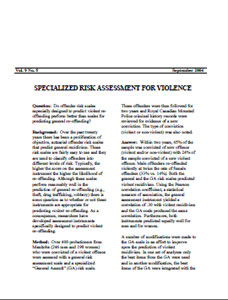Specialized risk assessment for violence
Research summary
Vol. 9 No. 5
September 2004
Question
Do offender risk scales especially designed to predict violent re-offending perform better than scales for predicting general re-offending?
Background
Over the past twenty years there has been a proliferation of objective, actuarial offender risk scales that predict general recidivism. These risk scales are fairly easy to use and they are used to classify offenders into different levels of risk. Typically, the higher the score on the assessment instrument the higher the likelihood of re-offending. Although these scales perform reasonably well in the prediction of general re-offending (e.g., theft, drug trafficking, robbery) there is some question as to whether or not these instruments are appropriate for predicting violent re-offending. As a consequence, researchers have developed assessment instruments specifically designed to predict violent re-offending.
Method
Over 400 probationers from Manitoba (246 men and 198 women) who were convicted of a violent offence were assessed with a general risk assessment scale and a specialized "General Assault" (GA) risk scale. These offenders were then followed for two years and Royal Canadian Mounted Police criminal history records were reviewed for evidence of a new conviction. The type of conviction (violent or non-violent) was also noted.
Answer
Within two years, 45% of the sample was convicted of new offence (violent and/or non-violent) with 24% of the sample convicted of a new violent offence. Male offenders re-offended violently at twice the rate of female offenders (33% vs. 14%). Both the general and the GA risk scales predicted violent recidivism. Using the Pearson correlation coefficient, a statistical measure of association, the general assessment instrument yielded a correlation of .30 with violent recidivism and the GA scale produced the same correlation. Furthermore, both instruments predicted equally well for men and for women.
A number of modifications were made to the GA scale in an effort to improve upon the prediction of violent recidivism. In one set of analyses only the best items from the GA were used and in another modification, the best items of the GA were integrated with the general assessment instrument in an effort to produce an enhanced risk scale. Neither modification produced improvements in the prediction of violent re-offending.
The results from this study showed that the general and specialized risk instruments that were used in Manitoba performed equally well in predicting violent re-offending. Although there were no differences in the predictive validities between the two scales in this jurisdiction, it is possible that a different violence risk scale may have produced a different result.
Policy implications
- Concerns over the need for specialized assessments of violent re-offending may be overstated. There may be situations where general offender risk scales can perform as well as a specialized violence risk scale. In these situations, staff training in the use of a violence risk scale would be superfluous.
- The finding that the two risk scales performed equally well for both male and female probationers suggests a commonality in risk factors across gender. Thus, knowledge of the risk factors among male offenders, where most of the research is conducted because of larger numbers, may be usefully applied to female offenders.
- Further research with other general and violent risk scales is needed to assess the generality of these findings. The results from this study may not apply to all violent risk scales or to all forms of violent re-offending (e.g., sexual recidivism).
Source
- Bourgon, G., & Bonta, J. Risk assessment for general assault and partner abusers. (User Report 2004-04). Ottawa: Public Safety Canada.
For further information
James Bonta, Ph.D.
Corrections Research
Public Safety Canada
340 Laurier Avenue West
Ottawa, Ontario
K1A 0P8
Tel 613-991-2831
Fax 613-990-8295
E-mail: Jim.Bonta@ps-sp.gc.ca
- Date modified:
